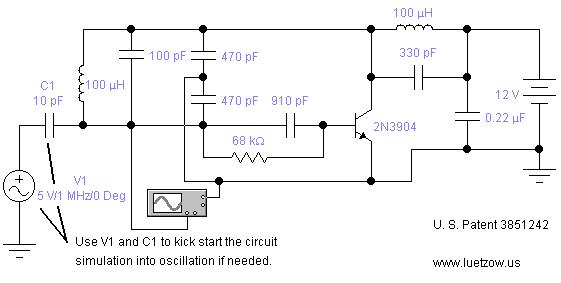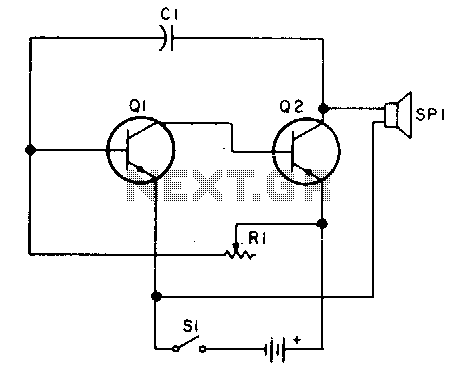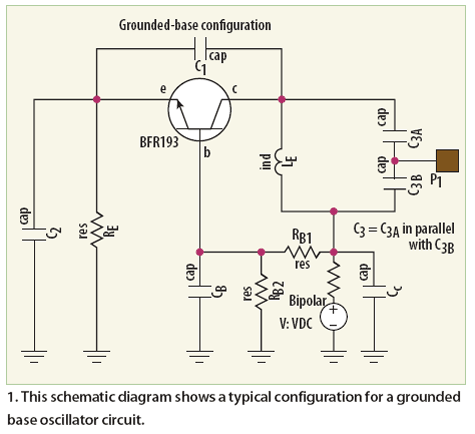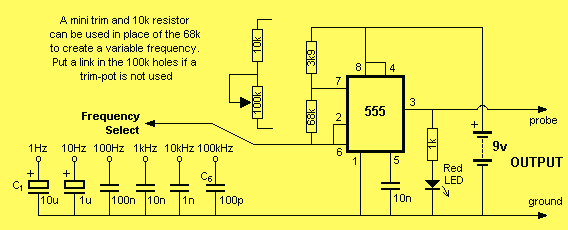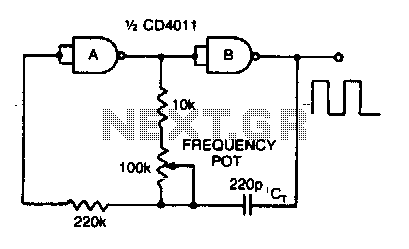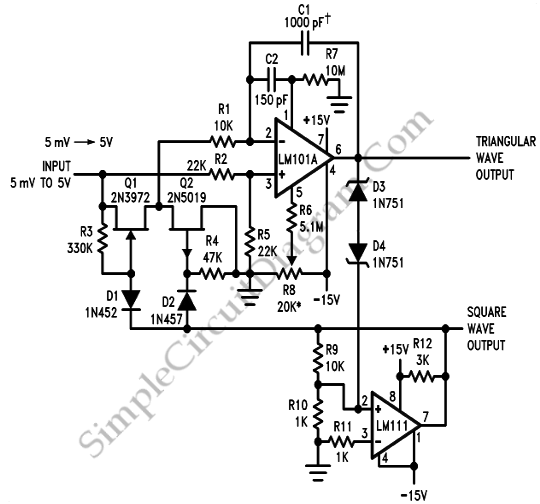
Tunnel Diode Relaxation Oscillator
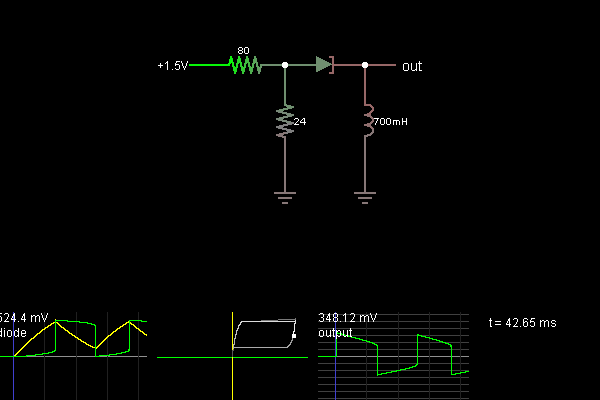
This example illustrates a tunnel diode utilized to create an oscillator. Two resistors are employed to bias the diode within its negative resistance region. As current flows through the inductor, the voltage across the tunnel diode rises until it reaches the negative resistance region of its characteristic curve. The inductor maintains a positive voltage, necessitating an increase in current, thereby preventing the tunnel diode from entering the negative resistance region. Instead, it transitions to the right side of the curve. At this point, the inductor experiences a negative voltage, causing the current to decelerate, and the tunnel diode follows the right side of its curve until it re-enters the negative resistance region. At this juncture, the tunnel diode jumps back to the left side of the curve, initiating the cycle anew.
The described oscillator circuit employs a tunnel diode, which is characterized by its unique I-V (current-voltage) characteristics, specifically exhibiting negative resistance. This property is crucial for oscillation, as it allows the diode to amplify signals under certain conditions. The circuit typically consists of a tunnel diode, two resistors for biasing, and an inductor.
The two resistors are strategically placed to ensure that the tunnel diode operates within its negative resistance region. This biasing is essential for maintaining oscillation, as it establishes the initial conditions required for the diode to switch between the positive and negative resistance states.
As current flows through the inductor, the voltage across the tunnel diode increases. When this voltage reaches a certain threshold, the diode enters the negative resistance region of its curve, which is critical for the oscillation process. However, due to the inductor's positive voltage, the circuit does not allow the tunnel diode to remain in this region. Instead, the diode transitions to the right side of the curve, where the inductor's voltage becomes negative, leading to a reduction in current flow.
This current reduction causes the tunnel diode to trace the right side of its curve until it once again reaches the negative resistance region. Upon reaching this point, the diode switches back to the left side of the curve, completing the cycle. The oscillation continues as long as the circuit is powered, with the inductor and tunnel diode working in tandem to produce a stable oscillating output.
The overall design of such an oscillator circuit is compact and efficient, making it suitable for various applications, including RF (radio frequency) oscillators, signal generators, and other electronic devices requiring precise oscillation. Proper selection of component values is critical to ensure stable operation and desired frequency output.This example shows a tunnel diode used to make an oscillator. The two resistors bias the diode in its negative resistance region. As the current begins to flow through the inductor, the voltage across the tunnel diode increases until it hits the negative resistance region of its curve. The inductor still has a positive voltage across it, which req uires an increse in current, so will not allow the tunnel diode to enter the negative resistance region. Instead, it jumps over to the right side of the curve. Now the inductor has a negative voltage, so the current slows down and the tunnel diode traces out the right side of its curve until it hits the negative resistance region again, at which point the tunnel diode jumps over to the left side of the curve and the cycle begins again.
🔗 External reference
The described oscillator circuit employs a tunnel diode, which is characterized by its unique I-V (current-voltage) characteristics, specifically exhibiting negative resistance. This property is crucial for oscillation, as it allows the diode to amplify signals under certain conditions. The circuit typically consists of a tunnel diode, two resistors for biasing, and an inductor.
The two resistors are strategically placed to ensure that the tunnel diode operates within its negative resistance region. This biasing is essential for maintaining oscillation, as it establishes the initial conditions required for the diode to switch between the positive and negative resistance states.
As current flows through the inductor, the voltage across the tunnel diode increases. When this voltage reaches a certain threshold, the diode enters the negative resistance region of its curve, which is critical for the oscillation process. However, due to the inductor's positive voltage, the circuit does not allow the tunnel diode to remain in this region. Instead, the diode transitions to the right side of the curve, where the inductor's voltage becomes negative, leading to a reduction in current flow.
This current reduction causes the tunnel diode to trace the right side of its curve until it once again reaches the negative resistance region. Upon reaching this point, the diode switches back to the left side of the curve, completing the cycle. The oscillation continues as long as the circuit is powered, with the inductor and tunnel diode working in tandem to produce a stable oscillating output.
The overall design of such an oscillator circuit is compact and efficient, making it suitable for various applications, including RF (radio frequency) oscillators, signal generators, and other electronic devices requiring precise oscillation. Proper selection of component values is critical to ensure stable operation and desired frequency output.This example shows a tunnel diode used to make an oscillator. The two resistors bias the diode in its negative resistance region. As the current begins to flow through the inductor, the voltage across the tunnel diode increases until it hits the negative resistance region of its curve. The inductor still has a positive voltage across it, which req uires an increse in current, so will not allow the tunnel diode to enter the negative resistance region. Instead, it jumps over to the right side of the curve. Now the inductor has a negative voltage, so the current slows down and the tunnel diode traces out the right side of its curve until it hits the negative resistance region again, at which point the tunnel diode jumps over to the left side of the curve and the cycle begins again.
🔗 External reference
Warning: include(partials/cookie-banner.php): Failed to open stream: Permission denied in /var/www/html/nextgr/view-circuit.php on line 713
Warning: include(): Failed opening 'partials/cookie-banner.php' for inclusion (include_path='.:/usr/share/php') in /var/www/html/nextgr/view-circuit.php on line 713
